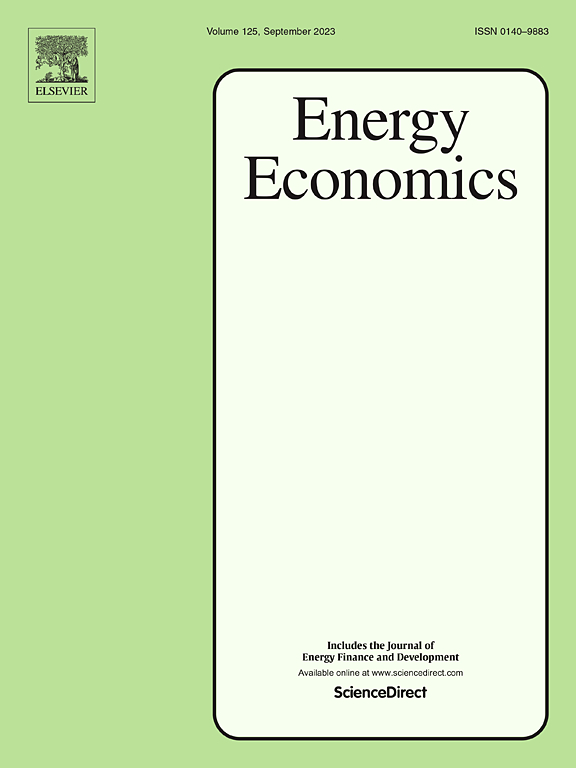Natural capital productivity as a decoupler of energy and emissions in Sub-Saharan Africa
IF 13.6
2区 经济学
Q1 ECONOMICS
引用次数: 0
Abstract
This paper explores the relationship between decarbonization processes and energy-economic growth coupling dynamics in less developed regions of Sub-Saharan Africa. Using comprehensive analytics, this study illuminates the twin effects of energy use on economic growth vis-à-vis sustainability through theoretical frameworks typified by the load capacity curve and environmental Kuznets curve hypotheses. Using the data of 39 Sub-Saharan African countries in panel dynamic fixed effect quantile ARDL (Autoregressive Distributed Lag) with Fourier function. The study supports U-shaped energy intensity effects on carbon intensity, which is flipped to an inverted U-shape via the moderating role of natural capital productivity capacity, thus contributing to decoupling the energy–carbon emissions relationship. The controlling factors included electrification, development, and industrialization levels in the sample countries where development contributes in decarbonization while others lead to demand-led carbonization. The analysis conducted in this paper not only pursues the scale effect of energy in aiding growth but also supports sustainability through the energy transition and energy conservation. The findings reveal that the decarbonization pathway does not necessarily require a fall in energy intensity but rather the expansion of natural capital productivity that can contribute to environmental development. Policymakers can optimize the decarbonization‑leading energy use and productivity investment portfolio using the developed model.

自然资本生产力作为撒哈拉以南非洲能源和排放的去耦因素
本文探讨了撒哈拉以南非洲欠发达地区去碳化进程与能源-经济增长耦合动态之间的关系。本研究采用综合分析方法,通过负荷能力曲线和环境库兹涅茨曲线假设等理论框架,阐明了能源使用对经济增长和可持续性的双重影响。研究使用了 39 个撒哈拉以南非洲国家的数据,这些数据均为带傅立叶函数的面板动态固定效应量化自回归分布滞后(ARDL)数据。研究支持能源强度对碳强度的 U 型影响,通过自然资本生产能力的调节作用,这种影响被翻转为倒 U 型,从而有助于能源-碳排放关系的脱钩。控制因素包括样本国家的电气化、发展和工业化水平,其中发展有助于去碳化,而其他因素则导致需求导向的碳化。本文的分析不仅探讨了能源在促进增长方面的规模效应,还通过能源转型和节能支持了可持续发展。研究结果表明,去碳化途径并不一定需要降低能源强度,而是需要扩大自然资本生产率,从而促进环境发展。政策制定者可以利用所开发的模型优化去碳化领先的能源利用和生产力投资组合。
本文章由计算机程序翻译,如有差异,请以英文原文为准。
求助全文
约1分钟内获得全文
求助全文
来源期刊

Energy Economics
ECONOMICS-
CiteScore
18.60
自引率
12.50%
发文量
524
期刊介绍:
Energy Economics is a field journal that focuses on energy economics and energy finance. It covers various themes including the exploitation, conversion, and use of energy, markets for energy commodities and derivatives, regulation and taxation, forecasting, environment and climate, international trade, development, and monetary policy. The journal welcomes contributions that utilize diverse methods such as experiments, surveys, econometrics, decomposition, simulation models, equilibrium models, optimization models, and analytical models. It publishes a combination of papers employing different methods to explore a wide range of topics. The journal's replication policy encourages the submission of replication studies, wherein researchers reproduce and extend the key results of original studies while explaining any differences. Energy Economics is indexed and abstracted in several databases including Environmental Abstracts, Fuel and Energy Abstracts, Social Sciences Citation Index, GEOBASE, Social & Behavioral Sciences, Journal of Economic Literature, INSPEC, and more.
 求助内容:
求助内容: 应助结果提醒方式:
应助结果提醒方式:


